VITA 76.0 Solves 10G Cabling Need
The VITA 76.0 connector ensures exceptional signal integrity for high-speed interconnects over maximum cable length on size-, weight-, and power (SWaP)-constrained ground, airborne, and naval platforms.
By Mike Southworth, Curtiss-Wright Defense Solutions, and Ken Braund, Meritec
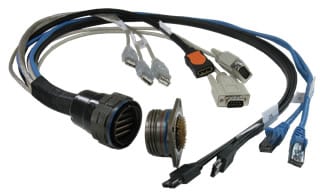 In 2015, VITA adopted the VITA 76.0 standard, “High Performance Cable – Ruggedized 10 Gbaud Bulkhead Connector for Cu and AOC Cables,” to define a new 38999-style connector: a new interface that marries a high-density, high-bandwidth mini-interconnect scheme and fits within the standard MIL-DTL-38999 circular shell. VITA 76.0 was then ratified as an ANSI standard in early 2016.
In 2015, VITA adopted the VITA 76.0 standard, “High Performance Cable – Ruggedized 10 Gbaud Bulkhead Connector for Cu and AOC Cables,” to define a new 38999-style connector: a new interface that marries a high-density, high-bandwidth mini-interconnect scheme and fits within the standard MIL-DTL-38999 circular shell. VITA 76.0 was then ratified as an ANSI standard in early 2016.
Until the emergence of VITA 76.0, system integrators had to choose between three less-than-desirable tradeoffs to take full advantage of a contemporary processor’s ability to support 10GbE, USB 3.0, and/or SATA 3.0. They either had to stick with the familiar and proven 38999 series connector and accept a reduction in performance and cable length, or alternatively had to adopt the Quadrax approach and accept its SWaP, density, and cost penalties. The third choice was a costly non-standard proprietary connector design.
VITA 76.0 offers the same ruggedization and environmental ratings as the traditional D38999 Series III by embedding a hermaphroditic (“Hermi”) contact design within a Qualified Production Listed (QPL) D38999 series III shell work. This contact Hermi design contact was pioneered and first commercialized by Meritec in the 1990s and was reliable over the course of 20+ years with millions of installed mated pairs in both commercial and military applications. Because VITA 76.0 utilizes standard, QPL circular shells, it provides designers with the flexibility to use readily available market-standard backshells and accessories with which they are already familiar.
For many years prior to VITA 76.0, the favored rugged I/O connector for deployed aerospace and defense subsystems, such as ATR boxes, had been the familiar MIL-DTL-38999 standard circular connector. Now in its 80th year of service, the 38999 series first emerged in the 1930s to address the need for higher reliability and greater survivability in high vibration, rugged military environments. Since then, the connector’s basic design has evolved to keep up with requirements for better EMI shielding, fluid resistance, and endurance to temperature, moisture, and dust exposure. Today, the MIL-DTL-38999 variation found most frequently in embedded systems is the Series III type, which connects via a triple-start, threaded coupling. Over the last 15 years, a dramatic increase in bandwidth requirements driven by Ethernet, DisplayPort, USB, SATA, InfiniBand, and others, has forced innovation, as the 38999’s familiar pin and socket contacts have proved inadequate to ensure signal integrity at the higher data rates at full cable length.
With the emergence of a new class of processors that support higher bandwidth interfaces, such as 10GbE, USB 3.0, PCI Express, and SATA 3.0, demand has emerged for a circular military grade connector that supports higher data rates.
Driving the recent increase in demand for the VITA 76.0 connector is the challenge of ensuring exceptional signal integrity for high-speed interconnects over maximum cable length on size-, weight-, and power- (SWaP) constrained ground, airborne, and naval platforms. The problem is simple: The faster the signal and longer the cable, the greater the signal degradation, and critical applications can’t accept signal loss or distortion. The higher data rates supported by new high-performance processors, such as Intel’s Xeon-D SoC, aren’t well suited for use with traditional pin and socket 38999 connectors since they severely limit cables to only a few feet in length. Consider that the 10GBASE-T standard (IEEE 802.3an-2006) supports 10Gb/s connections over unshielded or shielded twisted pair cables over CAT 6A or CAT7 twisted pair with a maximum range of 100 meters (330 ft.). The VITA 76.0 connector has been successfully validated by Meritec to support the full 100-meter cable length of the 10GBASE-T standard.
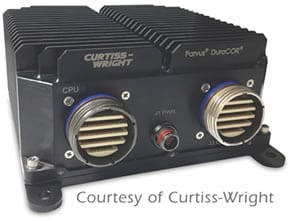 Curtiss-Wright’s Parvus DuraCOR XD1500 Small Form Factor (SFF) modular mission computer provides an example of a contemporary rugged embedded system that takes full advantage of the 100Ω impedance-matched VITA 76.0 connector to ensure the superior signal integrity of its multiple, high-speed 10GbE, USB 3.0, and other I/O interfaces.
Curtiss-Wright’s Parvus DuraCOR XD1500 Small Form Factor (SFF) modular mission computer provides an example of a contemporary rugged embedded system that takes full advantage of the 100Ω impedance-matched VITA 76.0 connector to ensure the superior signal integrity of its multiple, high-speed 10GbE, USB 3.0, and other I/O interfaces.
This rugged COTS system was designed to deliver ultra-rugged mission computer capabilities in the smallest, lightest envelope possible. It features a 12-core Xeon-class floating-point processing supported with up to 128GB of RAM, the highest capacity memory architecture available for embedded systems. With VITA 76.0 interconnect support for not only a comprehensive set of native Xeon-D high-speed I/O, this system also provides 150+ spare pins for add-on expansion I/O functionality from its XMC and mini-PCIe sites for mission-specific avionics/vetronics payload interfaces. This modularity and scalability enables mission-tailored capabilities for C4ISR command and control, image processing, surveillance, virtual machine hypervisor, datacenter server processing and network functional virtualization (NFV) applications in harsh deployed environments.
Prior to the advent of VITA 76.0, system designers who needed improved signal integrity to support high-speed signals but also wanted to stay with the traditional 38999 circular connector style would turn to Quadrax contacts within a 38999 shell. The Quadrax contact provides increased bandwidth by rearranging the signal and ground contacts within the circular shell with a considerable SWaP, density, and cost burden. Rather than re-designing the contact itself, as VITA 76.0 does, the Quadrax approach isolates the signals from each other to improve isolation from crosstalk.
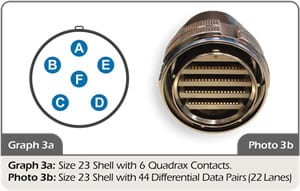 While increasing bandwidth capability, the Quadrax design severely sacrifices pin count and pin density. For example, a 38999 size 23 shell can accommodate six Quadrax contacts for a total of six bidirectional lanes, each capable of approximately 2.5Gb/s. This meant that four contacts were needed to support 10GbE (2.5G x 4). In comparison, the VITA 76.0 connectors have been lab-proven to support 10Gb/s data rates with differential pairs and grounds. Even better, with VITA 76.0 connectors, Meritec leverages shell work from QPL 38999 manufacturers and then integrates the Hermi contacts at substantially less cost than Mil-circular embedded Quadrax connectors.
While increasing bandwidth capability, the Quadrax design severely sacrifices pin count and pin density. For example, a 38999 size 23 shell can accommodate six Quadrax contacts for a total of six bidirectional lanes, each capable of approximately 2.5Gb/s. This meant that four contacts were needed to support 10GbE (2.5G x 4). In comparison, the VITA 76.0 connectors have been lab-proven to support 10Gb/s data rates with differential pairs and grounds. Even better, with VITA 76.0 connectors, Meritec leverages shell work from QPL 38999 manufacturers and then integrates the Hermi contacts at substantially less cost than Mil-circular embedded Quadrax connectors.
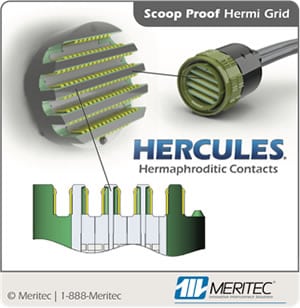 The new contact design used by VITA 76.0 connectors differs from traditional pin and socket design in that it uses a flat, hermaphroditic contact interface that is identical in both the cable plug and the receptacle.
The new contact design used by VITA 76.0 connectors differs from traditional pin and socket design in that it uses a flat, hermaphroditic contact interface that is identical in both the cable plug and the receptacle.
The flat profile lends itself to being stamped with minimal forming, resulting in cost savings as opposed to the higher capacitance and costlier, formed Quadrax contact. When mated, the Hermi flat mating surfaces provides two points of contact, providing for a smooth stub-less signal path between the receptacle and cable plug in comparison to the formed Quadrax contact scheme.
The Hermi contact design, along with the wire termination techniques used by VITA 76.0, provide a virtually transparent signal impedance path. There are none of the electrical stubs typically found in pin and socket designs. And, while many attempts have been made to embed commercial connectors such as Ethernet and USB within 38999 shells in order to make usable in rugged military environments, the new hermaphroditic contact design is a superior solution, both smaller and lighter, that delivers the bandwidth capabilities needed to accommodate the various protocols.
The VITA 76.0, shell size 23 supports 145 total contacts with 44 shielded differential pairs equaling 22 EMI/RFI shielded bidirectional lanes for an aggregate bandwidth of 220Gb/s per connector. The VITA 76.0 connector was designed to address signal integrity and high-density interface issues while enabling the system integrator to continue to use the standard threaded-coupling 38999 circular shell. Given that VITA 76.0 connectors are optimized for use with 10GbE copper interfaces, for example, and that industrial-temperature rated 10GBASE-T Ethernet transceivers are now available, it is anticipated that 10GbE capable systems will begin to proliferate in deployed applications that have historically been dominated by optical architectures. What’s more, since VITA 76.0 also supports coaxial interconnect requirements, the new connectors will also be utilized in video and RF applications.
VITA 76.0 defines six shell size variants: 23, 17, 15, 13, 11, and 9, four of which Meritec chose to tool—23, 17, 13 and 9—because the 11 and 15 shell sizes did not offer significant advantages over the 9 and 13 sizes, respectively.
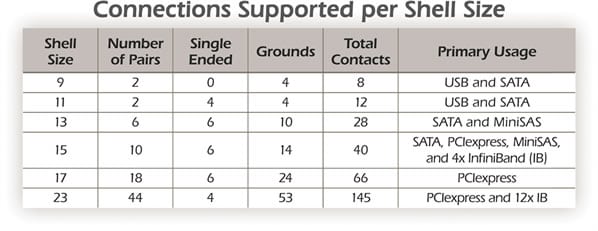
In comparison, the traditional 38999 connector in shell size 23 only supports 100 contacts and the slightly larger standard 38999 size 25 shell supports 128 contacts. With its 145 contacts, the size 23 VITA 76.0 can support 18x 10GbE lanes or an entire PCI Express x16 bus (82 contacts). The size 23 variant, with its smaller shell size, actually delivers 2.75x the differential pair density of Quadrax. Similarly, the shell size 17 VITA 76.0 connector provides 66 total contacts compared to the 55 supported by 38999 size 17. This enables the shell size 17 variant of VITA 76.0 to support eight 10G Ethernet ports or 18 differential pairs. The smallest variant of VITA 76.0, the shell size 9 connector, supports eight total contacts, compared to the six supported by standard 38999 shell size 9, and is well suited to handle one port of 10GBASE-T Ethernet.
Until the emergence of VITA 76.0, the options that were available to embedded system designers to meet the signal integrity challenge was limited to the traditional pin and socket 38999 series connectors that are not validated to support 10GbE in copper-based BASE-T copper configurations or the 38999 using the Quadrax contact scheme, which has several SI, SWaP, and density penalties. Instead, designers have had to turn to much costlier fiber optic interfaces in order to support 10Gb/s I/O from their chassis. Another area of frustration has come from system designers with requirements for video capture/encoders. The issue here is the recent growth in popularity of high-definition serial digital interface (HD-SDI) cameras, which were originally developed for the broadcast industry. Lately, they’ve been increasingly adopted for use in many deployed applications, such as onboard helicopters or ground vehicles. The problem is that while HD-SDI cameras are designed to transmit over a coax line, 38999 connectors don’t traditionally support coax. Instead, system integrators have had to use special inserts with their 38999 connector shells or use completely different non-military connectors in order to support such cameras.
Meanwhile, innovation in connector design continues apace: a field-terminated version of the VITA 76.0 connector is currently in design. Additionally, two proof-of-concept Active Optic versions have been presented before the VITA body thus allowing for either a copper cable or a fiber cable to be mated with the same panel mounted receptacle. System engineers looking for SWaP improvements within their 10G systems can now look to the VITA 76.0/ANSI Standard for the numerous options and advantages that this system offers.
Mike Southworth is product marketing manager for Curtiss-Wright Defense Solutions, where he is responsible for the small-form-factor rugged mission computers and Ethernet networking subsystem product line targeting SWaP-constrained military and aerospace applications.
Alan Roath, senior engineer, and Ken Braund, business development manager, are responsible for a broad array of Meritec’s market segments, including Flat Flex, MSI, and Mil/Aero Product Lines, and other high-performance connector and cabling solutions.
Photos courtesy of Bill Dutchman, senior engineer, special projects manager at Meritec.
Meritec and its West Coast affiliate, Joy Signal Technology, are signal integrity leaders and preferred vertically integrated manufacturers of high‐performance electrical and electronic interconnect embedded systems and connectors. With five decades of innovation, the company serves worldwide markets with cost‐effective solutions specializing in ruggedized mil/aero/defense/marine, telecom and datacom, automotive, industrial, medical, automatic test equipment, computer, audio/video, gaming, security, vending, and power connector products.
Interested in a specific market? Click a market below for current articles and news.
Automotive, Consumer, Industrial, Medical, Mil/Aero, Datacom/Telecom, and Transportation








